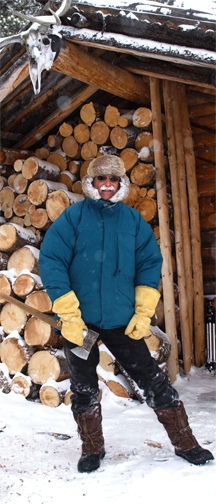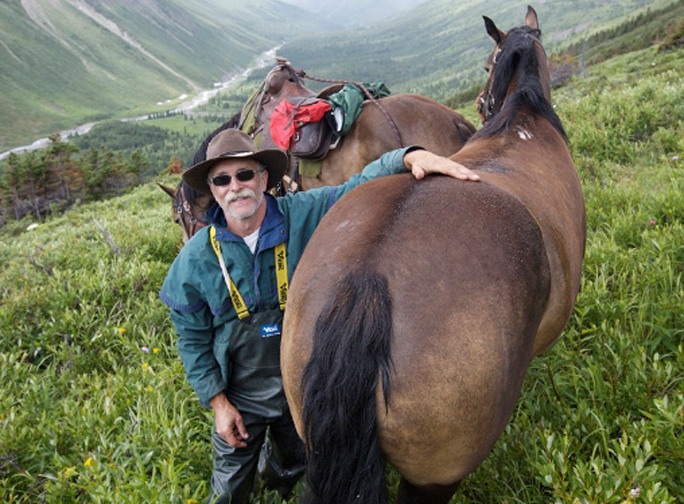

A WILDERNESS LIFE
"I was finally living the wilderness life I craved. I have snowshoed, hiked and ridden many hundreds of miles through these wild mountains. Out on a night as black as pitch, the temper- ature twenty below, I have set my boots, socks and pants on the ice, then eased into the knee-deep water of an icy stream to heave a sunken snow- mobile onto the bank. The roar of avalanches, the wail of moose calling in the cool grey morning, the howl of a wolf pack, and myriad other echoes of the wilderness have wakened my body and stirred my soul."
Wayne Sawchuk, Muskwa-Kechika: The wild heart of Canada's Northern Rock- ies.
Wayne Sawchuk, Muskwa-Kechika: The wild heart of Canada's Northern Rock- ies.
WAYNE SAWCHUK

Throughout his youth and young adulthood, Wayne Sawchuk struggled with the disparity between life as a logging contractor and the call of the wild. In the early 1990s, he decided to devote his life to conserving nature and her vast resources. He first started by working to protect the Mountain Creek Valley south of Dawson Creek, now protected by the Pine-Lemoray Provincial Park. As he became aware of the theory of Conservation Biology he began to work to protect B.C's Northern Rockies, a crucial component of the Yellowstone to Yukon Initiative. The result was the protection of the largest working wilderness in British Columbia, the Muskwa-Kechika Management Area.
Wayne remains vigilant in ensuring that these models continue to be sustainable. He believes that the framework he uses is adaptable to any environment on Earth, and is available to assist others in applying the theory to their backyards. He promotes the Muskwa-Kechika through the media, speaking engagements, consultation and mediation, as well as his ongoing work to document the land.
Wayne Sawchuk is driven by a vision of humanity co-existing peacefully and prosperously with nature. While his ideal world may sound utopian, Wayne is very much a realist. He knows what it takes to bring government, industry and other stakeholders to the table, uncover mutual interests and agree upon actions that maximize benefits for all - including the environment.
Wayne remains vigilant in ensuring that these models continue to be sustainable. He believes that the framework he uses is adaptable to any environment on Earth, and is available to assist others in applying the theory to their backyards. He promotes the Muskwa-Kechika through the media, speaking engagements, consultation and mediation, as well as his ongoing work to document the land.
Wayne Sawchuk is driven by a vision of humanity co-existing peacefully and prosperously with nature. While his ideal world may sound utopian, Wayne is very much a realist. He knows what it takes to bring government, industry and other stakeholders to the table, uncover mutual interests and agree upon actions that maximize benefits for all - including the environment.
Early Exploration
Wayne was raised primarily in Northeastern British Columbia, Canada. He began his life as the son of a logging and land clearing contractor. His family moved from one jobsite to the next throughout the wooded lands and coastline of British Columbia. Wayne joined the crew when he grew older, eventually co-owning a logging operation with his father.
In the off seasons, Wayne gathered up horses and friends, heading for the Rocky Mountains and boreal forests in his backyard. Wayne needed that respite with nature. And what a glorious, adventurous time it was! An avid writer and photographer, Wayne began documenting these epic excursions.
Although Wayne enjoyed working in the bush, he began to experience a fundamental shift in values in early adulthood. "I couldn't escape the jarring contrast between the scarred and roaded industrial landscapes where my family worked, and the wildlife-rich, pristine wilderness I visited in the all-too-short northern summers," he mused. His off-season expeditions became more frequent and lasted longer each year.
In the late 1980s Wayne sold his interest in the family company, leaping at the chance to purchase his uncle Norman's wilderness trapline on the Gataga River in the Northern Rockies.
In the off seasons, Wayne gathered up horses and friends, heading for the Rocky Mountains and boreal forests in his backyard. Wayne needed that respite with nature. And what a glorious, adventurous time it was! An avid writer and photographer, Wayne began documenting these epic excursions.
Although Wayne enjoyed working in the bush, he began to experience a fundamental shift in values in early adulthood. "I couldn't escape the jarring contrast between the scarred and roaded industrial landscapes where my family worked, and the wildlife-rich, pristine wilderness I visited in the all-too-short northern summers," he mused. His off-season expeditions became more frequent and lasted longer each year.
In the late 1980s Wayne sold his interest in the family company, leaping at the chance to purchase his uncle Norman's wilderness trapline on the Gataga River in the Northern Rockies.
The Muskwa-Kechika
The early 1990s found Wayne vigorously pursuing a number of local, regional, national and international environmental goals. He became a founder and President of the Chetwynd Environmental Society and launched a campaign to save the Mountain Creek Valley, one of the last unlogged watersheds in the South Peace area. He sat on the Board of Directors for Canadian Parks and Wilderness Society (CPAWS). In late 1992 a fortuitous meeting with George Smith, then the National Conservation Director for CPAWS, marked the beginning of a friendship and campaign to protect BC's Northern Rockies, by far the province's largest wilderness, and the wildest remaining chunk of the entire Rocky Mountains.
The importance and fragility of this area was illuminated by a BC Ministry of Forests mapping project, called the "Inventory of Undeveloped Watersheds". This map revealed a network of fifty pristine watersheds covering over 6.4 million hectares (15 million acres) located in northern BC. The area, encompassing large parts of B.C's Northern Rockies and Cassiars, eventually became known as the Muskwa-Kechika, named for the two great rivers that flowed through the heart of this vast wilderness.
During this same time period, the British Columbia government initiated community-based Land and Resource Management Plans (LRMPs) across the province. The goal of the LRMPs was to zone areas for the full range of uses, from industrial development to long-term environmental protection. Planning tables made up of government, industry and special interest stakeholders determined regional LRMPs. The LRMPs in the Muskwa-Kechika gave Wayne and George the opportunity to pursue their vision of conservation biology for the region. Wayne acted as the conservation representative on each of the three LRMP's that dealt with the Northern Rockies. The resultant Muskwa-Kechika model (known as the MK Management Area) thrives to this day.
The importance and fragility of this area was illuminated by a BC Ministry of Forests mapping project, called the "Inventory of Undeveloped Watersheds". This map revealed a network of fifty pristine watersheds covering over 6.4 million hectares (15 million acres) located in northern BC. The area, encompassing large parts of B.C's Northern Rockies and Cassiars, eventually became known as the Muskwa-Kechika, named for the two great rivers that flowed through the heart of this vast wilderness.
During this same time period, the British Columbia government initiated community-based Land and Resource Management Plans (LRMPs) across the province. The goal of the LRMPs was to zone areas for the full range of uses, from industrial development to long-term environmental protection. Planning tables made up of government, industry and special interest stakeholders determined regional LRMPs. The LRMPs in the Muskwa-Kechika gave Wayne and George the opportunity to pursue their vision of conservation biology for the region. Wayne acted as the conservation representative on each of the three LRMP's that dealt with the Northern Rockies. The resultant Muskwa-Kechika model (known as the MK Management Area) thrives to this day.
A Broader Vision
Wayne is encouraged by the successful implementation of this vision from the small-scale preservation of valleys like that of Mountain Creek, now protected by the Pine-Lemoray Provincial Park, to the largest working wilderness in British Columbia (an area larger than the province of Nova Scotia), both part of the international Yellowstone to Yukon project. He believes that the Conservation biology model is globally applicable - and essential.
Wayne is a Fellow International (FI’09) of the Explorers Club of New York, and a Fellow of the Royal Canadian Geographical Society. He is also a long serving member of the Muskwa-Kechika Advisory Board.
Wayne is a Fellow International (FI’09) of the Explorers Club of New York, and a Fellow of the Royal Canadian Geographical Society. He is also a long serving member of the Muskwa-Kechika Advisory Board.
